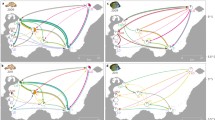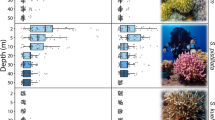Synopsis
Coral reef fishes almost universally disperse over relatively great distances during a pelagic larval phase. Barlow (1981) suggested that this dispersal is adaptive because adult fishes inhabit a patchy, uncertain environment. This reiterated an older idea that the random extinction of local populations necessarily favours dispersal, since ultimately all populations of non-dispersers will disappear. Whereas this view is based on adult survival, we emphasize a less frequent view that substantial larval dispersal may be adaptive when offspring experience patchy and unpredictable survival in the pelagic habitat. We do not address the question of why these animals ‘broadcast’ rather than ‘brood’, but suggest that species committed to pelagic offspring will be under selection to disperse siblings to spread the risk of failure among members of a cohort. Our arguments are supported by a heuristic computer simulation.
Similar content being viewed by others
References cited
Bainbridge, R. 1957. The size and shape and density of marine phytoplankton concentrations. Biol. Rev. 32: 91–115.
Barlow, G.W. 1981. Patterns of parental investment, dispersal and size among coral-reef fishes. Env. Biol. Fish. 6: 65–85.
Bunt, J.S. 1975. Primary productivity of marine ecosystems. pp. 169–183. In: H. Lieth & R.H. Whittaker (ed.) Primary Productivity of the Biosphere, Springer-Verlag, New York.
Den Boer, P.J. 1968. Spreading of risk and stabilization of animal numbers. Acta. Biotheor. 18: 165–194.
Doherty, P.J. 1983. Diel, lunar and seasonal rhythms in the reproduction of two tropical damselfishes: Pomacentrus flavicauda and P. wardi. Mar. Biol. 75: 215–224.
Ehrlich, P.R. 1975. The population biology of coral reef fishes. Ann. Rev. Ecol. Syst. 6: 211–247.
Fasham, M.J.R. 1978. The statistical and mathematical analysis of plankton patchiness. Oceanogr. Mar. Biol. Ann. Rev. 16: 43–79.
Hamner, W.M. & I.R. Hauri, 1981. Effects of island mass: water flow and plankton pattern around a reef in the Great Barrier Reef lagoon, Australia. Limnol. Oceanogr. 26: 1084–1102.
Houde, E.D. 1977a. Abundance and potential yield of the Atlantic thread herring,Opisthonema oglinum, and aspects of its early life history in the eastern Gulf of Mexico. U.S. Fish. Bull. 75: 493–512.
Houde, E.D. 1977b. Abundance and potential yield of the scaled sardine,Harengula jaguana, and aspects of its early life history in the eastern Gulf of Mexico. U.S. Fish. Bull. 75: 613–628.
Houde, E.D. & R.C. Schekter. 1978. Simulated food patches and survival of larval bay anchovy, Anchoa mitchelli, and sea bream. Archosargus rhomboidalis. U. S. Fish. Bull. 76: 483–487.
Houde, E.D. & R.C. Schekter. 1981. Growth rates, rations and cohort consumption of marine fish larvae in relation to prey concentrations. Rapp. P.-v. Reun. Cons. int. Explor. Mer. 178: 441–453.
Hunter, J.R. 1981. Feeding ecology and predation of marine fish larvae. pp. 33–77. In: R. Lasker (ed.) Marine Fish Larvae Morphology, Ecology, and Relation to Fisheries, University of Washington Press, Seattle.
Huntley, M. & E.R. Brooks. 1982. Effects of age and food availability on diel vertical migration of Calanus pacificus. Mar. Biol. 71: 23–31.
Isaacs, J.D., S.A. Tont & G.L. Wick. 1974. Deep scattering layers: vertical migration as a tactic for finding food. Deep-sea Research 21: 651–656.
Johannes, R.E. 1978. Reproductive strategies of coastal marine fishes in the tropics. Env. Biol. Fish. 3: 65–84.
Kuno, E. 1981. Dispersal and persistence of populations in unstable habitats: a theoretical note. Oecologia 49: 123–126.
Lasker, R. 1975. Field criteria for survival of anchovy larvae: the relation between inshore chlorophyll maximum layers and successful first feeding. U. S. Fish. Bull. 73: 453–462.
Laurence, G.C. 1974. Growth and survival of haddock (Melanogrammus aeglefinus) larvae in relation to planktonic prey. J. Fish. Res. Board Can. 31: 1415–1419.
Leis, J.M. & B. Goldman,1983. Studies on the biology of larval fishes in the Lizard Island area, northern Great Barrier Reef. pp. 221–225. In: J.T. Baker, R.M. Carter, P.W. Sammarco & K.P. Stark (ed.) Proceedings: Inaugural Great Barrier Reef Conference, Townsville, Aug. 28–Sept. 2,1983, James Cook University Press.
Mackas, D.L. & C.M. Boyd. 1979. Spectral analysis of zooplankton spatial heterogeneity. Science 204: 62–64.
Marliave, J.B. 1981. Vertical migrations and larval settlement in Gilbertidia sigalutes, F. Cottidae. Rapp. P.-V. Reun. Cons. int. Explor. Mer. 178: 349–351.
Menge, B.A. 1975. Brood or broadcast? The adaptive significance of different reproductive strategies in the two intertidal sea stars Leptasterias hexactis and Pisaster ochraceus. Mar. Biol. 31: 87–100.
Metz, J.A.J., T.J. de Jong & P.G.L. Klinkhamer. 1983. What are the advantages of dispersing; a paper by Kuno explained and extended. Oecologia 57: 166–169.
Mileikovsky, S.A. 1971. Types of larval development in marine bottom invertebrates, their distribution and ecological significance: a re-evaluation. Mar. Biol. 10: 193–213.
O'Connell, C.P. & L.P. Raymond. 1970. The effect of food density on survival and growth of early post yolk-sac larvae of the northern anchovy (Engraulis mordax Girard) in the laboratory. J. Exp. Mar. Biol. Ecol. 5: 187–197.
Omori, M. & W.M. Hamner. 1982. Patchy distribution of zooplankton: behavior, population assessment and sampling problems. Mar. Biol. 72: 193–200.
Palmer, A.R. & R.R. Strathmann. 1981. Scale of dispersal in varying environments and its implications for life histories of marine invertebrates. Oecologia 48: 308–318.
Reddingius, J. & P.J. Den Boer. 1970. Simulation experiments illustrating stabilization of animal numbers by spreading of risk. Oecologia 5: 204–284.
Russell-Hunter, W.D. 1970. Aquatic productivity: an introduction to some basic aspects of biological oceanography and limnology. MacMillan, New York. 306 pp.
Robertson, D.R. 1973. Field observations on the reproductive behaviour of a pomacentrid fish, Acanthochromis polyacanthus. Z. Tierpsychol. 32: 319–324.
Sale, P.F. 1978. Reef fishes and other vertebrates: a comparison of social structures. pp. 313–346. In: E.S. Reese & F.J. Lighter (ed.) Contrasts in Behaviour, Wiley-Interscience, New York.
Sale, P.F. 1980. The ecology of fishes on coral reefs. Oceanogr. Mar. Biol. Ann. Rev. 18: 367–421.
Sharp, G.D. 1980. Report of the workshop on effects of environmental variation on survival of larval pelagic fishes. pp. 15–65. In: G.D. Sharp (ed.) Workshop on Effects of Environmental Variation on Survival of Larval Pelagic Fishes, IOC workshop report 28, UNESCO.
Steele, J.H. 1978. Some comments on plankton patches. pp. 1–20. In: J.H. Steele (ed.) Spatial Pattern in Plankton Communities, Plenum Press, New York.
Strathmann, R.R. 1974. The spread of sibling larvae of sedentary marine invertebrates. Amer. Nat. 108: 29–44.
Strathmann, R.R. & M.F. Strathmann. 1982. The relationship between adult size and brooding in marine invertebrates. Amer. Nat. 119: 91–101.
Theilacker, G. & K. Dorsey. 1980. Larval fish diversity, a summary of laboratory and field research. IOC workshop report 28, UNESCO.
Thorson, G. 1950. Reproduction and larval ecology of marine bottom invertebrates. Biol. Rev. 25: 1–45.
Vance, R.R. 1973a. On reproductive strategies in marine benthic invertebrates. Amer. Nat. 107: 339–352.
Vance, R.R. 1973b. More on reproductive strategies in marine benthic invertebrates. Amer. Nat. 107: 353–361.
Van Valen, L. 1971. Group selection and the evolution of dispersal. Evolution 25: 291–298.
Walsh, J.J., C.D. Wirick, D.A. Dieterle & A.G. Tingle. 1981. Environmental constraints on larval fish survival in the Bering Sea. Rap. P.-v. Reun. Cons. int. Explor. Mer. 178: 24–27.
Weinstein, M.P., S.L. Weiss, R.G. Hodson & L.R. Gerry. 1980. Retention of three taxa of postlarval fishes in an intensively flushed tidal estuary, Cape Fear River, North Carolina. U.S. Fish. Bull. 78: 419–436.
Wolanski, E. 1983. Water circulation in the central and northern sections of the Great Barrier Reef. pp. 467–472. In: J.T. Baker, R.M. Carter, P.W. Sammarco & K.P. Stark (ed.) Proceedings: Inaugural Great Barrier Reef Conference, Townsville, Aug. 28–Sept. 2, 1983, James Cook University Press.
Author information
Authors and Affiliations
Rights and permissions
About this article
Cite this article
Doherty, P.J., Williams, D.M. & Sale, P.F. The adaptive significance of larval dispersal in coral reef fishes. Environ Biol Fish 12, 81–90 (1985). https://doi.org/10.1007/BF00002761
Received:
Accepted:
Issue Date:
DOI: https://doi.org/10.1007/BF00002761




